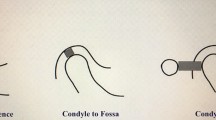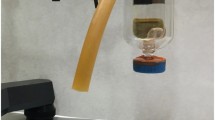Abstract
Purpose
The occipital condyles (OCs) are crucial anatomical structures in the cranial base. To our knowledge, there is no cone beam computed tomography (CBCT)-based study on the morphometric analysis of OCs. The aim of this study was to evaluate the morphometric analysis of OCs using CBCT.
Methods
CBCT images of 200 OCs from 100 patients of which 39 males and 61 females in the age group of 18–67 years were included in the study population. Linear and angular measurements of OCs were performed.
Results
The average OC width, length, height, sagittal angle, and effective height were 10.3 ± 1.3 mm, 19.6 ± 2.0 mm, 9.1 ± 1.4 mm, 7.4 ± 1.7 mm, and 35.3 ± 5.2 mm. Condylar width and sagittal angle measurements were found significantly different between the right and left sides; and were not found significant difference between the right and left sides in the measurements of condylar height, length, and effective height. Also the average intercondylar anterior distance (ICAD), intercondylar posterior distance (ICPD), distance between the basion and the anterior apex of the occipital condyle (B-AAOC), distance between the basion and posterior apex of the occipital condyle (B-PAOC), distance between the opisthion and anterior apex of occipital condyle (O-AAOC), and distance between the opisthion and posterior apex of occipital condyle (O-PAOC) were 20.9 ± 1.5 mm, 44.0 ± 2.0 mm, 12.3 ± 1.9 mm, 34.5 ± 4.2 mm, 29.8 ± 1.7 mm, and 27.0 ± 2.1 mm. There was not significant difference in the morphometric measurements among age groups. All morphometric measurements showed a significant difference depending on gender.
Conclusions
The morphometric evaluation of OCs may be effectively examined using CBCT. Linear and angular measurements data of OCs in the present study may be used as a reference database for future morphometric and surgical investigations.



Similar content being viewed by others
References
Anderson BW, Al Kharazi KA (2019) Anatomy, head and neck, skull. StatPearls Publishing LLC, Treasure Island
Bayrakdar IS, Miloglu O, Altun O, Gumussoy I, Durna D, Yilmaz AB (2014) Cone beam computed tomography imaging of ponticulus posticus: prevalence, characteristics, and a review of the literature. Oral Surg Oral Med Oral Pathol Oral Radiol 118:e210–e219. https://doi.org/10.1016/j.oooo.2014.09.014
Bosco A, Venugopal P, Shetty AP, Shanmuganathan R, Kanna RM (2018) Morphometric evaluation of occipital condyles: defining optimal trajectories and safe screw lengths for occipital condyle-based occipitocervical fixation in indian population. Asian Spine J 12:214–223. https://doi.org/10.4184/asj.2018.12.2.214
Bozbuga M, Ozturk A, Bayraktar B, Ari Z, Sahinoglu K, Polat G, Gurel I (1999) Surgical anatomy and morphometric analysis of the occipital condyles and foramen magnum. Okajimas Folia Anat Jpn 75:329–334
Bransford RJ, Lee MJ, Reis A (2011) Posterior fixation of the upper cervical spine: contemporary techniques. J Am Acad Orthop Surg 19:63–71
Brockmeyer DL, Jea A, Cohen AR, Menezes AH (2015) Introduction: craniocervical junction. Neurosurg Focus 38:E1. https://doi.org/10.3171/2015.1.focus1531
Brooks AL, Jenkins EB (1978) Atlanto-axial arthrodesis by the wedge compression method. J Bone Joint Surg Am 60:279–284
Cicekcibasi AE, Murshed KA, Ziylan T, Seker M, Tuncer I (2004) A morphometric evaluation of some important bony landmarks on the skull base related to sexes. Turk J Med Sci 34:37–42
Cohnen M, Kemper J, Mobes O, Pawelzik J, Modder U (2002) Radiation dose in dental radiology. Eur Radiol 12:634–637. https://doi.org/10.1007/s003300100928
Dagtekin A, Avci E, Hamzaoglu V, Ozalp H, Karatas D, Esen K, Bagdatoglu C, Baskaya MK (2018) Management of occipitocervical junction and upper cervical trauma. J Craniovertebr Junction Spine 9:148–155. https://doi.org/10.4103/jcvjs.JCVJS_72_18
Degno S, Abrha M, Asmare Y, Muche A (2019) Anatomical variation in morphometry and morphology of the foramen magnum and occipital condyle in dried adult skulls. J Craniofac Surg 30:256–259. https://doi.org/10.1097/scs.0000000000004925
Ebraheim NA, Lu J, Biyani A, Brown JA, Yeasting RA (1996) An anatomic study of the thickness of the occipital bone. Implications for occipitocervical instrumentation. Spine (Phila Pa 1976) 21:1725–1729 (discussion 1729–1730)
El-Gaidi MA, Eissa EM, El-Shaarawy EA (2014) Free-hand placement of occipital condyle screws: a cadaveric study. Eur Spine J 23:2182–2188. https://doi.org/10.1007/s00586-014-3488-3
Feiz-Erfan I, Gonzalez LF, Dickman CA (2005) Atlantooccipital transarticular screw fixation for the treatment of traumatic occipitoatlantal dislocation. Technical note. J Neurosurg Spine 2:381–385. https://doi.org/10.3171/spi.2005.2.3.0381
Frankel BM, Hanley M, Vandergrift A, Monroe T, Morgan S, Rumboldt Z (2010) Posterior occipitocervical (C0-3) fusion using polyaxial occipital condyle to cervical spine screw and rod fixation: a radiographic and cadaveric analysis. J Neurosurg Spine 12:509–516. https://doi.org/10.3171/2009.11.spine09172
Glynn MK, Sheehan JM (1983) Fusion of the cervical spine for instability. Clin Orthop Relat Res 179:97–101
Grob D, Crisco JJ 3rd, Panjabi MM, Wang P, Dvorak J (1992) Biomechanical evaluation of four different posterior atlantoaxial fixation techniques. Spine (Phila Pa 1976) 17:480–490
Hwang SW, Gressot LV, Chern JJ, Relyea K, Jea A (2012) Complications of occipital screw placement for occipitocervical fusion in children. J Neurosurg Pediatr 9:586–593. https://doi.org/10.3171/2012.2.peds11497
Kizilkanat ED, Boyan N, Soames R, Oguz O (2006) Morphometry of the hypoglossal canal, occipital condyle, and foramen magnum. Neurosurg Q 16:121–125. https://doi.org/10.1097/01.wnq.0000214018.49915.49
La Marca F, Zubay G, Morrison T, Karahalios D (2008) Cadaveric study for placement of occipital condyle screws: technique and effects on surrounding anatomic structures. J Neurosurg Spine 9:347–353. https://doi.org/10.3171/spi.2008.9.10.347
Le TV, Dakwar E, Hann S, Effio E, Baaj AA, Martinez C, Vale FL, Uribe JS (2011) Computed tomography-based morphometric analysis of the human occipital condyle for occipital condyle-cervical fusion. J Neurosurg Spine 15:328–331. https://doi.org/10.3171/2011.5.spine10778
Le TV, Vivas AC, Baaj AA, Vale FL, Uribe JS (2014) Optimal trajectory for the occipital condyle screw. J Spinal Disord Tech 27:93–97. https://doi.org/10.1097/BSD.0b013e31824e52a6
Lee KM, Yeom JS, Lee JO, Buchowski JM, Park KW, Chang BS, Lee CK, Riew KD (2010) Optimal trajectory for the atlantooccipital transarticular screw. Spine (Phila Pa 1976) 35:1562–1570. https://doi.org/10.1097/brs.0b013e3181c15a84
Li G (2013) Patient radiation dose and protection from cone-beam computed tomography. Imaging Sci Dent 43:63–69. https://doi.org/10.5624/isd.2013.43.2.63
Liang X, Jacobs R, Hassan B, Li L, Pauwels R, Corpas L, Souza PC, Martens W, Shahbazian M, Alonso A, Lambrichts I (2010) A comparative evaluation of cone beam computed tomography (CBCT) and multi-slice CT (MSCT) Part I. On subjective image quality. Eur J Radiol 75:265–269. https://doi.org/10.1016/j.ejrad.2009.03.042
Lin SL, Xia DD, Chen W, Li Y, Shen ZH, Wang XY, Xu HZ, Chi YL (2014) Computed tomographic morphometric analysis of the pediatric occipital condyle for occipital condyle screw placement. Spine (Phila Pa 1976) 39:E147–E152. https://doi.org/10.1097/brs.0000000000000105
Ludlow JB, Ivanovic M (2008) Comparative dosimetry of dental CBCT devices and 64-slice CT for oral and maxillofacial radiology. Oral Surg Oral Med Oral Pathol Oral Radiol Endod 106:106–114. https://doi.org/10.1016/j.tripleo.2008.03.018
Naderi S, Korman E, Citak G, Guvencer M, Arman C, Senoglu M, Tetik S, Arda MN (2005) Morphometric analysis of human occipital condyle. Clin Neurol Neurosurg 107:191–199. https://doi.org/10.1016/j.clineuro.2004.07.014
Nadim Y, Lu J, Sabry FF, Ebraheim N (2000) Occipital screws in occipitocervical fusion and their relation to the venous sinuses: an anatomic and radiographic study. Orthopedics 23:717–719
Okamura A, Nakaoka M, Ohbayashi N, Yahara K, Nabika S (2016) Intraoperative cone-beam computed tomography contributes to avoiding hypoglossal nerve palsy during transvenous embolization for dural arteriovenous fistula of the anterior condylar confluence. Interv Neuroradiol 22:584–589. https://doi.org/10.1177/1591019916654141
Ozer MA, Celik S, Govsa F, Ulusoy MO (2011) Anatomical determination of a safe entry point for occipital condyle screw using three-dimensional landmarks. Eur Spine J 20:1510–1517. https://doi.org/10.1007/s00586-011-1765-y
Saluja S, Das SS, Vasudeva N (2016) Morphometric analysis of the occipital condyle and its surgical importance. J Clin Diagn Res 10:Ac01–Ac04. https://doi.org/10.7860/jcdr/2016/23278.8800
Sandor GK, Korpi JT, Ylikontiola LP, Salokorpi N, Katisko J, Kumpulainen T (2013) Navigation-assisted Le Fort I osteotomy with midpalatal split to treat compressive pathologies of the craniovertebral junction. J Oral Maxillofac Surg 71:e120–e125. https://doi.org/10.1016/j.joms.2012.09.025
Santos-Nunez G, Lo HS, Kotecha H, Jose J, Abayazeed A (2018) Imaging of spine fractures with emphasis on the craniocervical junction. Semin Ultrasound CT MR 39:324–335. https://doi.org/10.1053/j.sult.2018.04.003
Schulze D, Heiland M, Thurmann H, Adam G (2004) Radiation exposure during midfacial imaging using 4- and 16-slice computed tomography, cone beam computed tomography systems and conventional radiography. Dentomaxillofac Radiol 33:83–86. https://doi.org/10.1259/dmfr/28403350
Singh O, Das JM (2019) Anatomy, head and neck, jugular foramen. StatPearls Publishing LLC, Treasure Island
Smucker JD, Sasso RC (2006) The evolution of spinal instrumentation for the management of occipital cervical and cervicothoracic junctional injuries. Spine (Phila Pa 1976) 31:S44–S52. https://doi.org/10.1097/01.brs.0000218244.48569.37(discussion S61)
Srivastava A, Nanda G, Mahajan R, Nanda A, Mishra N, Karmaran S, Batra S, Chhabra HS (2017) Computed tomography-based occipital condyle morphometry in an Indian population to assess the feasibility of condylar screws for occipitocervical fusion. Asian Spine J 11:847–853. https://doi.org/10.4184/asj.2017.11.6.847
Stock GH, Vaccaro AR, Brown AK, Anderson PA (2006) Contemporary posterior occipital fixation. J Bone Joint Surg Am 88:1642–1649
Takahata M, Yamada K, Akira I, Endo T, Sudo H, Yokoyama H, Iwasaki N (2018) A novel technique of cervical pedicle screw placement with a pilot screw under the guidance of intraoperative 3D imaging from C-arm cone-beam CT without navigation for safe and accurate insertion. Eur Spine J 27:2754–2762. https://doi.org/10.1007/s00586-018-5706-x
Takigawa T, Simon P, Espinoza Orias AA, Hong JT, Ito Y, Inoue N, An HS (2012) Biomechanical comparison of occiput-C1–C2 fixation techniques: C0–C1 transarticular screw and direct occiput condyle screw. Spine (Phila Pa 1976) 37:E696–E701. https://doi.org/10.1097/brs.0b013e3182436669
Uribe JS, Ramos E, Vale F (2008) Feasibility of occipital condyle screw placement for occipitocervical fixation: a cadaveric study and description of a novel technique. J Spinal Disord Tech 21:540–546. https://doi.org/10.1097/BSD.0b013e31816d655e
Vaccaro AR, Lim MR, Lee JY (2005) Indications for surgery and stabilization techniques of the occipito-cervical junction. Injury 36(Suppl 2):B44–B53. https://doi.org/10.1016/j.injury.2005.06.014
van Steenbergen TRF, van der Geest ICM, Rovers MM, Janssen D, Futterer JJ (2019) Feasibility study of intraoperative cone-beam CT navigation for benign bone tumour surgery. Int J Med Robot Comput Assist Surg 15:e1993. https://doi.org/10.1002/rcs.1993
Yasa Y, Ocak A, Bayrakdar IS, Duman SB, Gumussoy I (2017) Morphometric analysis of sella turcica using cone beam computed tomography. J Craniofac Surg 28:e70–e74. https://doi.org/10.1097/scs.0000000000003223
Funding
This study was not funded by any organization.
Author information
Authors and Affiliations
Contributions
IG project development, data analysis, manuscript writing, and editing. SBD project development, data collection, data management, data analysis, manuscript writing, and editing.
Corresponding author
Ethics declarations
Conflict of interest
Authors declare that they have no conflict of interest
Ethical approval
All procedures performed in studies involving human participants were in accordance with the 1964 Helsinki declaration and its later amendments or comparable ethical standards.
Informed consent
For this type of study, formal consent is not required.
Additional information
Publisher's Note
Springer Nature remains neutral with regard to jurisdictional claims in published maps and institutional affiliations.
Rights and permissions
About this article
Cite this article
Gumussoy, I., Duman, S.B. Morphometric analysis of occipital condyles using alternative imaging technique. Surg Radiol Anat 42, 161–169 (2020). https://doi.org/10.1007/s00276-019-02344-2
Received:
Accepted:
Published:
Issue Date:
DOI: https://doi.org/10.1007/s00276-019-02344-2




